Croissants – A La Julia Child
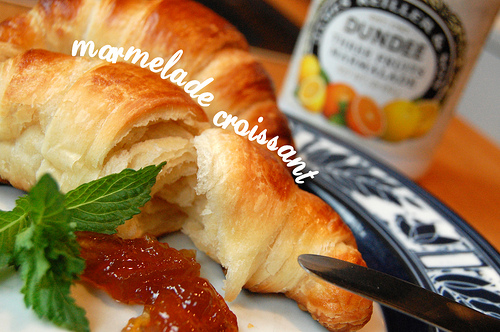
In honor of my culinary hero Julia Child and upcoming movie about her life Julie & Julia (where Meryl Streep plays Julia Child, and Julie Powell is played by Amy Adams) I decided to bake one of her recipes from her TV show The French Chef With Julia Child 2 – Croissants.
Although the process might sound intimidating it is in fact quite simple. Hey – if a rookie like Julia could make it, you can make it too! I will go with you step-by step as presented by Julia in her show. Read along – it is fun and delicious!
Julia Child, More Than A Character
As she goes through her rolling pins collection in the Croissants episode of her late 1960’s TV show The French Chef, where she flamboyantly throws one of them in the trash bin, concluding that “It’s good for nothing, I don’t know why I keep it”, or as she encourages you to take heart when you flip anything in a pan to do it with the “courage of your convictions”, while she spills most of her potatoes on the stove top, Julia Child – the pioneer of cooking shows, gives hope for cooking newbies like you and me who feel so small and intimidated while watching modern big-wig cooking shows where everything turns out perfect, manicured and shiny!
I was extremely excited to hear of the Julie & Julia movie and from what I’ve seen of the trailer, Meryl Streep does an outstanding acting in playing the role of this extraordinary woman! Can’t wait to watch it on 7th of August!
Le Croissant
Considered the donut rival in America (and rightly so), the croissant gained quick popularity in every pastry shop, continental breakfast plate, and even in donut chains. Charles Dickens wrote about the Croissant in his 1872 All Year Round periodical, “the workman’s pain de ménage and the soldier’s pain de munition, to the dainty croissant on the boudoir table“.
But it’s humble origins are mentioned long before that year, when August Zang (an Austrian artillery officer) opened the Boulangerie Viennoise in 1838 in Paris featuring the popular kipfel, that inspired the French pastry chefs to roll out a nationalized version calling it Le Croissant, due to its crescent shape.
Le Recipe
As intimidating (and cliche) as it probably sounds – if you can make a humble omelet, you CAN bake a beautiful batch of 12 Croissants. I mustered up enough courage by watching Julia’s episode on how to make Croissants, and being baking a couple of successful batches since then – well, one of them turned out more browner than needed as I left them in the oven too long [ahem!]. The nice thing about it is that the dough can be prepared ahead of time, and frozen so when you are planning on baking, all you need to do is to get your oven going and your appetite. There are a lot of Croissants recipes, I am sure, but just for the sake of celebrating the movie and the women who inspired it, I’ll stick with her version.
[ad#300×250-green]
Flour Options
Probably the most important step in the recipe is to use the right flour type for this type of pastry. Julia suggests using a low-gluten flour so the dough can be easily rolled without becoming rubbery, etc. You could for instance use a mix of 1 part unbleached all-purpose and 2 parts unbleached pastry flour. She also adds tasteless oil to the mix, to help tenderize the dough.
Yeast Dough
Even if today’s dry yeast has a very small chance of failing to do its job, I will give it a chance to prove itself to be worthy of our croissant dough.
1 Tsp dry yeast
1/4 Tsp salt
1/2 Tb sugar
1/4 cup warm water (not more than 110 degrees, otherwise you’ll kill the yeast)
Start by mixing all these ingredients with the warm water until dissolved, and let it sit for 5 min. If the yeast is active (and it should) it will form a soft foamy mass on its surface:
Croissant Dough
No big secret here to be learned. Make sure that when you measure “1 cup of flour” you actually sweep off the excess with the edge of a knife so you will have a consistent quantity. The quantities given here are good for a batch of 12 croissants. I usually double it and freeze a half of the dough (after I have the butter in it).
2 Cups of your flour mix (see Flour Options above).
1 Tb sugar
3/4 Tsp salt
1/3 to 1/2 cups tepid milk
if using unbleached flour: 2 Tb vegetable oil (I used Canola)
if using bleached flour: 4 Tb vegetable oil
Blend all the above in a mixing bowl (don’t forget the yeast mix) with a spatula into a sticky mass, then out on the board:
Time for some punching – works well when you are mad. Julia suggests the lift-and-throw motion and as she talks and demonstrates the moves, the dough gets stuck to her pastry scraper and goes flying as she exclaims “Whew!” and goes on with her explanation without any trouble… Typical Julia Child! Love it. Un-edited fun!
Keep on being rough with your dough for about 3 minutes – it’ll be somewhat sticky at first but after a good rapid fold and knead with the heels of your hands it will become elastic, smooth and will not stick to your hands anymore:
Time to rise. Plop the dough into a bowl and do a criss-cross scissors snip on its surface to help it rise. Then cover it with a plastic wrap, and let it rise until it becomes double in bulk:
Rising time depends on the room temperature. I found that if I do this in the summer, rising is faster than in winter. About 1 to 1-1/2 hours at say 75 degrees will suffice. Don’t keep it in temperatures higher than 85 degrees or longer that needed (over-rise) since that wll impart an unpleasant taste. At this point you can retard the rising by placing the bowl in the refrigerator:
Then, punch it down into a flat circle, wrap it in wax-paper and chill it for about 20-30 minutes. The chilling is important as it makes working the dough much easier: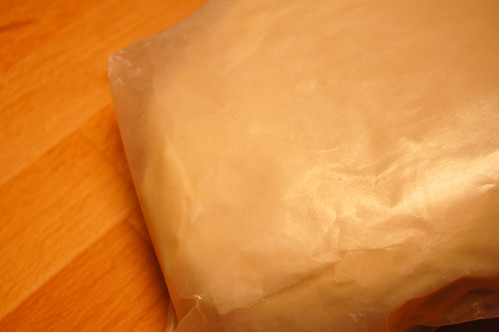
Rolls, Turns and Chills
If the croissant recipe would be considered a somewhat complicated procedure, than this particular step would probably be the one that will need more attention. What makes this basic yeast dough (good for bread, etc.) become a croissant dough is a good old stick of chilled butter. It is butter that makes the world turn. And it is butter that will make the 82 dough layers for our croissants: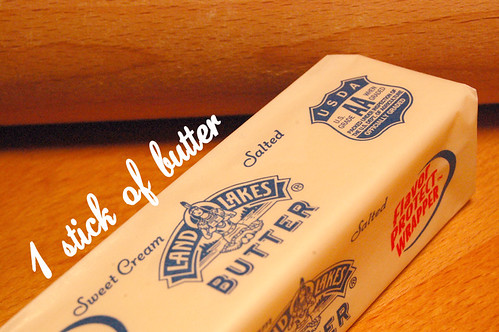
Time is now to beat the daylight out of this chilled butter with your rolling pin. The idea here, my friends, is to work the butter into a malleable consistency, free of lumps and very fast, to keep the butter cold – working with melted butter is just not fun: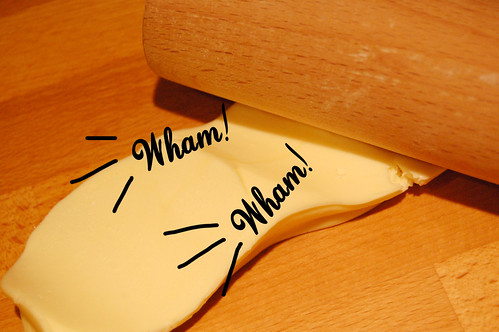
Then finish this procedure by pushing the whacked butter bits by bits out with the heel of your hand, so it is completely lump-free: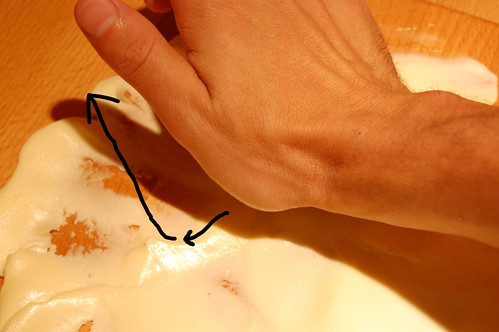
Lovely, huh? Having fun yet? Now, press your dough (I roll it) into an approximate 9″ diameter circle, then form the butter into a 5″ square (square-ish in my case) and place it on the top of your dough (centered):
Now gently flip the dough edges (without ripping it!) over the butter and seal in the butter by pinching the dough: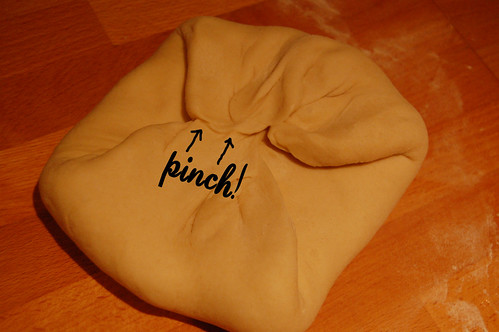
Voila! now you have a nice package of dough with a stick of butter inside, ready to be massaged into many layers. For that, flour your rolling pin and both sides of your dough, place it on your board with the seal side up and start gently rolling back and forth from the center towards the edges to form a rectangle of about 15″ long and 5″ wide. It doesn’t HAVE to be exact, but try to at least get close to that dimension. If there are butter bits that poke through, just pinch the dough over that spot to re-seal it. Also, if the dough became too rubbery (read warm), chill it again for about 20 minutes and continue from where you’ve left it. What you want here is to evenly spread the butter between the two dough layers (this gets you ready for your next step):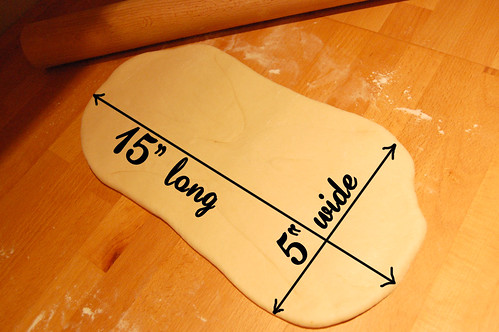
Turns #1 and #2
Okay. What’s a turn in culinary lingo? Julia Child defines it as having the dough folded like a business letter in 3 even layers. And really, that’s exactly what it is. Gently fold the bottom of your rectangle to the center of the dough then fold the top flap over it the same way. That’s defined as turn #1:
Then once again, roll out the dough to the initial 15″ long and 5″ wide rectangle to prepare it for turn #2 just as before. Keep the edges as straight as possible (I re-align them with the rolling pin). You will see that it will look more like a rectangle than before. Rinse and repeat – you got it right?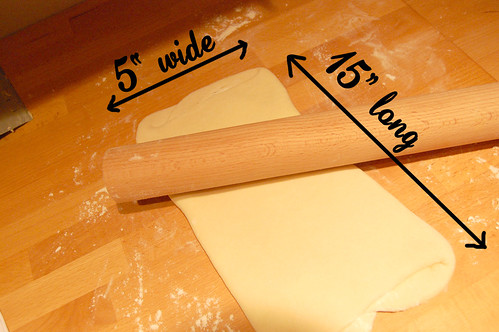
By this time (after turn#2) your dough needs some chilling to be able to roll it another 2 turns. Leave it folded as a business letter, flour it lightly, wrap it in wax-paper and place it in the fridge for about 1-2 hours:
Turns #3 and #4
After the time spent in the fridge (1 to 2 hours) the dough is relaxed and ready for turn #3 and turn #4. Really nothing special here. Just repeat the same process as for the previous two turns – two rollings into the 15″ long and 5″ wide rectangle and two business letter style folding. You will end up with 81 layers of butter between 82 layers of dough. Again, by this time the dough is probably getting to rubbery to work with, so back in the fridge it goes for a 2 hours chill.
Croissants Shaping
After the 2 hour chill, out of the fridge the croissant dough comes and onto a lightly floured board. This time roll it into a 20″ long by 5″ wide rectangle. Try to keep the edges as straight as possible: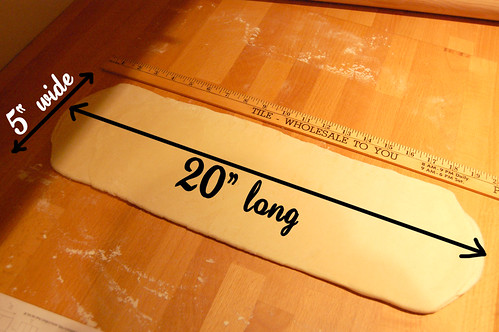
Next, make a middle crosswise cut and chill one half:
Now, roll the one half of the croissants dough into a 12″ long by 5″ wide rectangle and cut it in thirds and chill two of the thirds:
Now take one of the thirds and roll it into a 5-1/2″ square and cut it on the bias. Mine here doesn’t look terribly square-ish but you get the idea: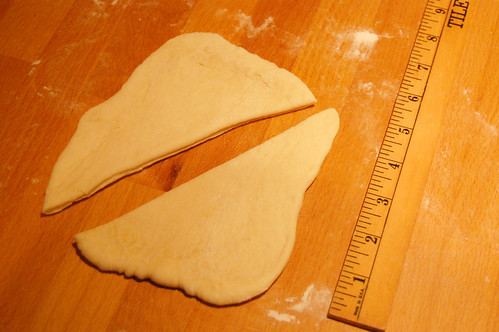
Roll the triangles out to extend to about 7″ long and shape it as much as you can into a isosceles triangle (where two sides are equal in length). Now starting at the base, roll up the dough towards the tip of the triangle, then bend it into a crescent moon form, and place it on a buttered 12″ x 14″ baking sheet (not too close to each other so they don’t fuse together while rising and baking) with the tip of the triangle on the bottom so that it wouldn’t unwrap during baking. Form the rest of the dough the same way into a total of 12 croissants, and let it rest for an hour covered with a plastic wrap. This might be a good time to get your oven going – set it to 475 degrees (mine takes about 45 minutes to heat up). You can freeze the risen croissants for later baking and pop them in the oven while frozen:
Glazing and Baking
Again, no rocket science here. Simple egg-wash. Paint the risen croissants with one egg beater mixed with 1/2 Tsp water:
Then pop them in the pre-heated 475 degree oven and really – keep an eye on them because they bake very fast. Usually something between 10 to 15 minutes depending on how dark brown you want them to look. Don’t do any other activities during this fast bake – you will forgot about the oven like I did so many times. I tend to leave them in until they turn dark-brown. Let them cool on a rack for about 10 minutes and resist the temptation of eating – the are HOT!: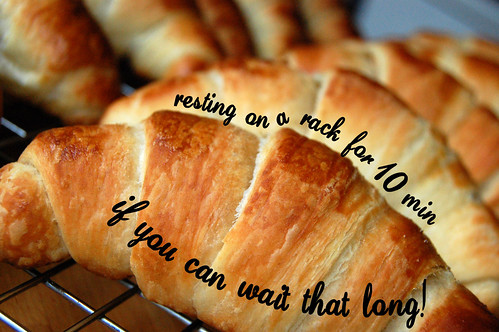
Voila!
Julia mentions in the episode that she could eat Croissants in the morning, for lunch, for dinner, mid-morning or mid-night snack and so on. And I don’t blame her. These evil Croissants are so wicked delicious that can be enjoyed throughout the day. I tend to like them in the morning and for lunch, as a sandwich, or simply with any sort of jam or marmalade. Too bad we don’t have Le Figaro, the French news paper that Julia grabs at the end of the show while sitting down and enjoying her caffé au lait, and freshly baked croissant.

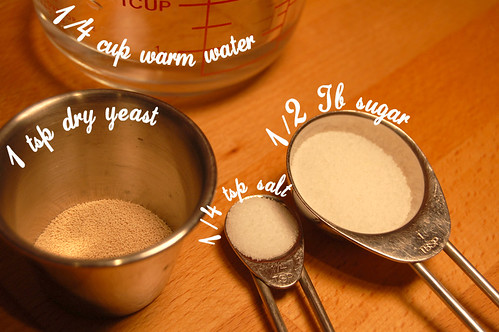
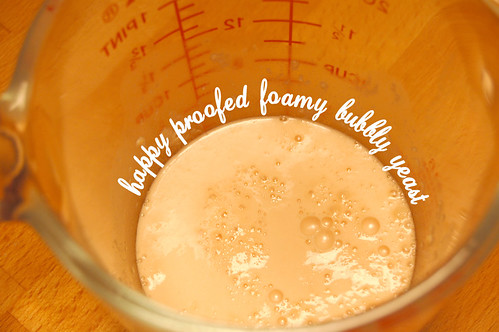
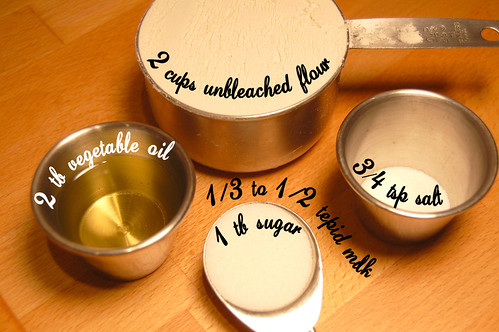
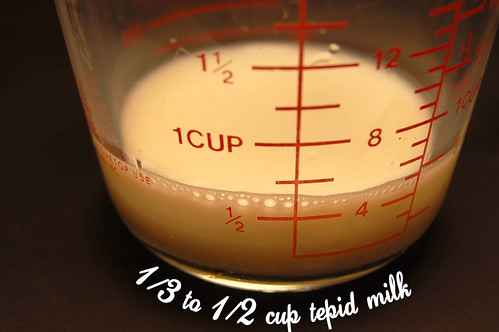

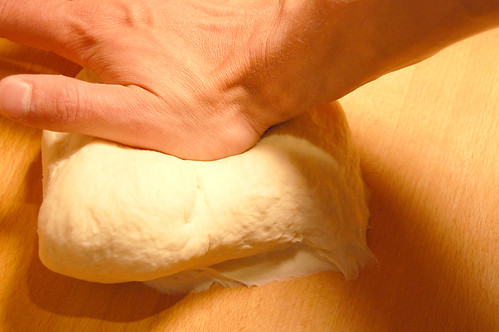

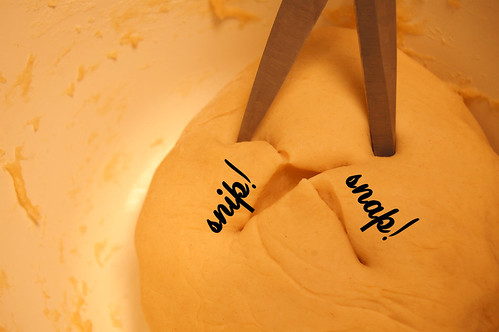

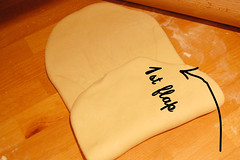
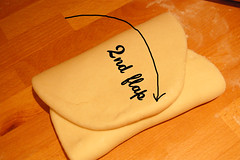

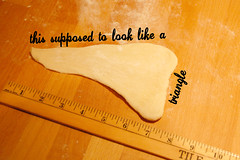
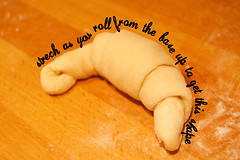

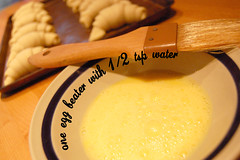
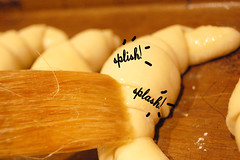




 facebook
facebook instagram
instagram twitter
twitter
Heya Gabi,
I’m Nora – writing in from Singapore. Room temperature is close to 90˚F / 32˚C here.
You’re post comes in as a GREAT help. I tried making the croissant as per your step by step instructions. I ended up with 9 pieces. Baked 2 and froze the rest. Will be baking the other 7 on Tuesday. (Today’s Sunday).
The 2 tasted fantastic. After Tuesday’s baking. I intend to make them again, this time round, twice the recipe, and in bigger pieces. My question is, with double the recipe, eg 4 cups flour, 2 sticks butter, etc, will I need to proof them longer than 1 and a half hours? (The step after “snip” snap” with scissors). If so, for how long? Also I find that after shaping the dough into croissant shapes and leaving them for 1 hour, they did not rise so much (like Nano).
I’m using unbleached flour all the way. Will using 3 tsp of oil (per 1 recipe) make the croissant more flaky? Would really like that.
Please advise.
Looking forward and will keep in touch!
Nora! Thanks for writing and fur trusting my Croissants recipe!
I would proof the same amt of time considering that the yeast’s action works the same regardless of the dough mass. On using 3 Tbs of oil per recipe, I suspect it will add to the flakiness indeed. Let me know how the next batch turns out.
This is great info for me – having an army of you out there test-proofing my recipe!!
OMG!
these were amazing..i absolutely love love love this recipe! and thnx to whoever wrote it for all the detailes in thr process =D
although time consuming these are definetly worth it!!! the smell when their in the oven is simply wonderful!
Isabel – Glad you liked it!! So were they delicious??
You’re a doll.
Thank you Denya – Hahaha – that’s an expression that’s used typically in Romania – I am familiar with it. But I assure you – I AM REAL! Thanks for the comment!
I used rapid rise yeast is it still going to work?? Also when it calls for 1 stick of butter….Your meaning 1/2 cup of butter right?? Just wanted to make sure I’m using the right amount for this recipe since I’ve always wanted to make croissants but just been to scared to go through all the steps and have it not turn out!! Since I doubled the recipe does it mean I need to roll out the dough bigger or keep it the same size??? One more question My oven seems to cook things really fast and uneven should I put my rack up higher and cook them at a lower temp?? Or maybe use parchment paper.
Chov, it will still work but the flavor will not be there as the rapid rise yeast eats the sugars very fast. Yep, 1 butter stick or 1/2 cup. I would recommend doing a single batch at first instead of double. You learn a lot on the first batch. I would still roll it as a single size instead of a double – takes up too much counter-space and muscles. Plus you’ll end up fighting with the dough as it becomes too elastic as it slowly warms up. The parchment paper will only help to not stick. I would use the middle rack and keep peeking in every 5 minutes or so, plus rotate the tray once for even browning. It really helps to know your oven and its hot spots.
Well.those photos are amazing…absolutely wonderful, though seem DIFFICULT to make, am a big fialure in baking especially recipes requires rising,,,,my dough never rises:(((
any way I loved that movie,brilliant as much as i loved your blog.
Thanks Nesrine! Thanks for commenting! Your dough never rises?? That shouldn’t happen. What are you doing wrong? Should be a simple process. What type of yeast are you using? Also what temperature do you have there when you rise your dough?
oh me oh my this looks tasty. I’ve always wanted to try her recipe but never had the chance to. This gives me confidence 🙂
foarte faine croissante mi-au iesit urmand reteta de aici! si ce miros iese din cuptor cand le coci…. felicitari pentru blog, pozele sunt clare si lamurioare , comentariile haioase te fac sa crezi ca totul e simplu ca “buna ziua” , desi croissantuil mi se parea mie piatra de incercare in patiserie …. dar uite ca mi-au iesit! multumiri si spor la treaba in continuare 🙂
i’ve tried the recipe but it didn’t work for me! maybe i used much flour… and when i put the butter it was very limpy so i added like 2 cups of flour again… and when i had to roll them in order to shape the croissants they didn’t ressambled the once in your pic… It was soooo hard to do… =( can you maybe tell me what did i do wrong? =D
After one try and thinking I was a failure, I tried your recipe.. and its amaizing. I love the step by step pictures and istructions. Tres bon. You just gave me some confidence in me 😀
I was so pleased to find a reasonably easy recipe for croissants when i came across this one. Although I think I messed up at the butter step. When you did the butter and rolled it, could you see the butter through? I think I may have rolled the dough too flat before adding the butter, making it too thin. I will try again though! Thank you for sharing the wonderful recipe
Andreas – sorry to near that. Not sure what to say. Too many things might have gone wrong. Did you use regular unbleached flour?
Yennifer — glad to hear! You are not a failure even if the croissant recipe might fail! thanks for the comment!
Tammy – I could see bits of the butter (small ones, like 1/4″ or so). Use a ruler to measure the first rolling (9″ diameter). Also I thing the folding of the dough over the butter and pinching (sealing) is important.
My first try at getting the yeast to rise failed. I think because I put in too much salt inadvertently. Then, the second time the yeast sort-of rose but when I set it to rise, it didn’t do anything. I threw the blob away and started over. This time, I excluded the salt in the yeast, measured the temperature of the water for the yeast to 110 degrees and put a little more sugar in. I also used a half cup of milk (I used soy because we are out of cow milk). Third time was a charm and everything else went really well. The rolls came out great. Thanks for the great pictures and explanation. Super — thanks!
Ahh…. help. My dough was waay too sticky to work with. I kept adding flour till I could. It proofed lovely, butter smoothed out great, but when it came to folding and rolling out, the butter kept coming thru! I ended up with a butter mess all over the place. Tried pinching to keep it in, but as soon as I would try rolling, out it came again!
This attempt ended with my dough kissing the trash can. But I’m not done, not by a long shot.
Hi Jed. Thanks for the feedback and congrats!! I suspect that the first two times you might have killed the yeast with the high water temperature. Is your thermometer calibrated? The water for the yeast proofing should be luke-warm. Try using say 90-95 degrees F water.
Christian. Sorry for the problems. Let’s see. What type of flour are you using? Are you chilling the dough before adding the chilled butter for 30 min? Also chilling between each turn? I think there lies the secret of success. Let me know.
I was very intimitated by the cookbook version of croissants, but your pictures have given me hope. I’ll let you know how it goes 🙂
Hey there, tomorro morning Im gonna try bakin these lovely croissants! not for myself, but for a lovely gentleman! I am a great cook, but not a baker 😉
Please, tell me one thing: how much is one STICK of butter? In supermarket they are not even sticks, but 250g rectangles! How many grams do I need for this recipe?
Thanks n wish me luck pls:)
Hi Gabi-
Awesome post. THANK YOU for the step by step photos-most helpful! I’ve made criossants by another recipe but had waaaaaay to much butter seeping out of my finished product(yuk). I’m looking to try your recipe posted here.
I do have 2 questions: 1) Can I use high gluten flour (aka bread flour)? 2) I assume that a cinnamon sugar mix sprinkled prior to rolling into cresents will have no deleterious effects? I’d like to make these tomorrow & send my hubby off to work with fresh cinnamon croissants on monday. :o)
Thanks again & Happy New Year!
These croissants look delicious!! I was just want to make these so bad… but I just wanted to ask if pastry mix could be used in replacement of pastry flour. Is there a difference between the two?
1 stick butter = 113 grams, so cut the 250g block in half
Post-making note: sprinkling cinn & sugar tasted great. Some recommend spreading the “turning process” out over days to allow a better flavor to develop as the dough ferments. This works well for pizza dough, so I’ll bet it works for this too. Will do next time.
Thanks for sharing the detailed steps by steps method and the recipe. Now, I have more confidence in trying out the baking of croissants after reading your post. Thanks again. 🙂
A ginormous thank you for this. Will try this this week!!!
I love your photos and labels! I recently tried making sourdough croissants with pretty good success. It just takes longer rising times, which is an opportunity to anticipate the arrival of buttery croissants! I think the sourdough flavor doesn’t really compete with the butter anyways, so they don’t taste much different.
http://transportedtastes.blogspot.com/2011/04/sourdough-croissant-adventure.html
Hi, those photos are really helpful! This was my second attempt at making croissants and although the results were much better than my first attempt i still had some problems. When doing the turns my dough was expanding sideways as well as vertically so i had to keep folding the sides back in to keep it recatangular, also when finally shaped my croissants didn’t rise much at all, certainly not triple their original size. I used unbleached flour and the right amount of oil. I checked my yeast before i used it and it is definately still active (i made pizza dough about a week ago so i knew it was ok anyway). I’m sure i didn’t kill it by overheating. I didn’t cheat with the turns, and i let the croissants do their final rise overnight in the fridge, i then left them out in the kitchen for a good 2 hours to get rid of the chill. What i ended up wth was something inbetween cake and croissant. I think the layers are actually ok, the problem was they croissants didn’t rise enough to get air inbetween the layers (i think). Should i use more yeast? i only used 1tsp as in the recipe and i did make 12 croissants out of the recipe.
I don’t know why but I can’t get past the butter package. Every time I try to do the fold and roll it just falls apart. So I guess I need a lot of practice! Any suggestions?
Love, Love, Love the step by step direction and pictures! Made them and they were delectable. My family, who are impossible to please, loved them. Thank you for posting this!
Holly! Glad to hear this! My pleasure!! I need to make a batch these days as weather is more forgiving lately in Chicago.
I’ve always been scared of making croissants. But my husband just got back from Brasil — a few pounds heavier and he said it was all due to the lovely baked goods they have – the more he described how delicious they were (and they were all homemade) the more i wanted to try to create that good smell he was describing in our home. Anyway, i found your recipe and it has taken me all day but I am to the point of putting them in the oven and wanted to thank you for making this such an easy process. Your pictures and instructions are great! Heres looking forward to that first warm buttery, flakey bite.
Cathy! Thanks so much for writing! Glad to hear that my blog post inspired you. Please let us know they turned out!!
What a fantastic post! SO informative … and I loved the part about croissants being light in weight, not calories 😀
Thank you for this excellent post!
I have a question that shows what an amatuer I am but i need to know> when you cover the dough in plastic wrap to let it rise do you cover the bowl that the dough is in or the dough itself?
Gabriella – only the bowl. Also make sure you spray the surface of the dough with oil spray otherwise it will stick to the plastic wrap. Hope it helps!
FABULOUS directions – you’ve brought a complicated, intimidating bread to those that want to try it. Thank you SO much! I’ve bookmarked this amazing blog post and buzzed!
Gabi-
This recipe is absolutely AMAZING!!! Thank you for the post, my family loved the croissants and are requesting then for breakfast almost every morning now. Definitely going to make a large batch and freeze it. 😉
I am going to visit my little sister soon and i really want to bake these croissants with her, she loves these kind of activities. The problem is I am a measurement maniac and I don’t know how much a cup/ a tsp/ a butter stick is in grams. Can you please help me with that? I really want to make them perfect.
Thank you for the great step-by-step instructions and the clever photos. I just returned from Paris, and am depressed by the lack of a decent croissant in Chicago. When I screw up my courage, I am going to try this recipe.
Sounds good! Hopefully this croissant will be close to what you’ve tasted in Paris!! Let me know!
What a great post! So happy you put in the information about how/when to freeze- that helps save time and is so convenient! I love the pics and am excited to try this, thanks!
Just stumbled onto your site. I love it! Great photos, very clear instructions and your croissants look delicious. Will definitely be using this recipe. Thank you!
Just had the best almond croissant at Renaud’s in Santa Barbara and was inspired to make homemade croissants. Found your blog through random google search and gave this recipe a try the same day. thanks so much for your post. I appreciated the background information on croissants and Julia Child’s recipe and your step by step instructions with photos for every critical step. It was a breeze following. I used 1 part unbleached all-purpose flour and 2 parts whole wheat pastry flour. I don’t think I let my croissants rise long enough before sticking them into the oven because even though they came out soft, the layers didn’t quite separate. From previous posts, I dropped the oven down to 425 so maybe that affected the baking too? not sure. regardless, the flavor turned out wonderful. I stuffed a few with semi-sweet chocolate and they were the best!
I followed the receipe, made great tasting croisssant…..but…the bottoms burned. WHy? I mean burned not just brown! the top was perfect!! is it the cooking sheet?
Thanks
Ali – it might be that you are too close to the lower burner. Can you place the tray on the upper oven rack? Also having a pizza stone in there helps… That plays the role of a heat buffer.
Thanks so much for the feedback! I will have to stuff some chocolate bits in my croissants one day. There might be several issues with the croissants turning out soft and the layers not separating. One reason might be the rising environment temperature. If it’s on a hot summer day (80F degrees), the dough rises violently after the 1-1/2 hours. If colder, then it might need a longer time.
I don’t think loosing those 50F degrees played a major role… My only advice is to try the recipe again, and note everything you made differently. I might be able to troubleshoot. Also did you use active dry yeast or instant yeast? Try active dry yeast. Here’s a discussion on several types of yeast you can find in the stores – might be useful: http://www.wildyeastblog.com/2008/01/12/instant-yeast/#yeast-conversions